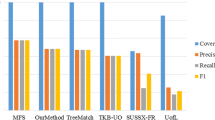Abstract
Word sense disambiguation (WSD) and coreference resolution are two fundamental tasks for natural language processing. Unfortunately, they are seldom studied together. In this paper, we propose to incorporate the coreference resolution technique into a word sense disambiguation system for improving disambiguation precision. Our work is based on the existing instance knowledge network (IKN) based approach for WSD. With the help of coreference resolution, we are able to connect related candidate dependency graphs at the candidate level and similarly the related instance graph patterns at the instance level in IKN together. Consequently, the contexts which can be considered for WSD are expanded and precision for WSD is improved. Based on Senseval-3 all-words task, we run extensive experiments by following the same experimental approach as the IKN based WSD. It turns out that each combined algorithm between the extended IKN WSD algorithm and one of the best five existing algorithms consistently outperforms the corresponding combined algorithm between the IKN WSD algorithm and the existing algorithm.
Access this chapter
Tax calculation will be finalised at checkout
Purchases are for personal use only
Preview
Unable to display preview. Download preview PDF.
Similar content being viewed by others
References
Navigli, R.: Word sense disambiguation: A survey. ACM Computing Surveys 41(2) (2009)
Snyder, B., Palmer, M.: The English all-words task. In: ACL Senseval-3 Workshop 2004 (2004)
Decadt, B., Hoste, V., Daelemans, W.: GAMBL, Genetic Algorithm Optimization of Memory-Based WSD. In: ACL Senseval-3 Workshop 2004 (2004)
Yarowsky, D., Florian, R.: Evaluating sense disambiguation across diverse parameter spaces. J. Nat. Lang. Eng. 9(4) (2002)
Cuadros, M., Rigau, G.: Quality assessment of large scale knowledge resources. In: EMNLP 2006 (2006)
Navigli, R., Velardi, P.: Structural Semantic Interconnections: A Knowledge-Based Approach to Word Sense Disambiguation. IEEE Trans. Pattern Anal. Mach. Intell. 27(7) (2005)
Sinha, R., Mihalcea, R.: Unsupervised graphbased word sense disambiguation using measures of word semantic similarity. In: ICSC 2007 (2007)
Navigli, R., Lapata, M.: Graph connectivity measures for unsupervised word sense disambiguation. In: IJCAI 2007 (2007)
Agirre, E., Soroa, A.: Personalizing PageRank for Word Sense Disambiguation. In: EACL 2009 (2009)
Pham, T.P., Ng, H.T., Lee, W.S.: Word Sense Disambiguation with Semi-Supervised Learning ACL 2005 (2005)
Mihalcea, R.: Using Wikipedia for AutomaticWord Sense Disambiguation. In: NAACL 2007 (2007)
Lee, Y.K., Ng, H.T.: An empirical evaluation of knowledge sources and learning algorithms for word sense disambiguation. In: EMNLP 2002 (2002)
Hu, S., Liu, C., Zhao, X., Kowalkiewicz, M.: Building Instance Knowledge Network for Word Sense Disambiguation. To appear in Proceedings of the 33rd Australasian Computer Science Conference, ACSC 2011 (2011), http://www.ict.swin.edu.au/personal/cliu/
Klein, D., Manning, C.: Fast Exact Inference with a Factored Model for Natural Language Parsing. In: NIPS 2002 (2002)
Stanford_Parser, http://nlp.stanford.edu/software/lex-parser.shtml
Fellbaum, C.: WordNet – an electronic lexical database. MIT Press, Cambridge (1998)
Versley, Y., Moschitti, A., Poesio, M., Yang, X.: Coreference Systems based on Kernel Methods. In: Coling 2008 (2008)
Versley, Y., Ponzetto, S.P., Poesio, M., Eidelman, V., Jern, A., Smith, J., Yang, X., Moschitti, A.: BART: A Modular Toolkit for Coreference Resolution. In: Companion Volume ACL 2008 s(2008)
Miller, H., Leacock, C., Tengi, R., Bunker, R.: A semantic concordance. In: ARPA Workshop on HLT (1993)
Navigli, R.: A structural approach to the automatic adjudication of word sense disagreements on NLE 2008 (2008)
Author information
Authors and Affiliations
Editor information
Editors and Affiliations
Rights and permissions
Copyright information
© 2011 Springer-Verlag Berlin Heidelberg
About this paper
Cite this paper
Hu, S., Liu, C. (2011). Incorporating Coreference Resolution into Word Sense Disambiguation. In: Gelbukh, A.F. (eds) Computational Linguistics and Intelligent Text Processing. CICLing 2011. Lecture Notes in Computer Science, vol 6608. Springer, Berlin, Heidelberg. https://doi.org/10.1007/978-3-642-19400-9_21
Download citation
DOI: https://doi.org/10.1007/978-3-642-19400-9_21
Publisher Name: Springer, Berlin, Heidelberg
Print ISBN: 978-3-642-19399-6
Online ISBN: 978-3-642-19400-9
eBook Packages: Computer ScienceComputer Science (R0)




